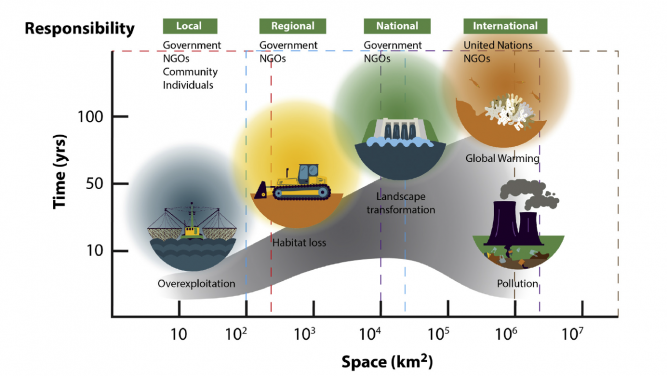Media
HKU Conservation Biologists Urge for Needs of Win-win Strategies to Tackle Proximal and Horizon Threats to Biodiversity
23 May 2019

Space–Time Templet to Identify Proximal and Horizon Threats to Biodiversity
The templet is an example of how to conceptualize multiple threats across different time/space scales and identify the most appropriate level of intervention for each threat (local, regional, national, and international). The placement of each threat in this templet may shift according to circumstances – for example, pollution may occur across multiple spatial scales (indicated by the grey background) – and the best level of response will shift accordingly. These threats to biodiversity (as well as others not included in this figure) will also interact with each other, compounding and accelerating loss of biodiversity. Source: Trends in Ecology & Evolution
With an ever-growing list of threats facing biodiversity on multiple scales, conservationists struggle to determine which to address. A common reaction is to prioritise their efforts on threats to individual species or management areas, HKU conservation biologists argue that this narrow-minded approach is detrimental to the overall goal of saving species and ecosystems worldwide. Instead, in an article published in the journal Trends in Ecology & Evolution on May 23, they urge for the needs of large-scale, long-term collaboration to tackle proximal and horizon threats to biodiversity.
“We are in a pivotal moment when we cannot just protect species from immediate and localised threats,” said Dr Louise Ashton from the School of Biological Sciences of The University of Hong Kong (HKU), “We also need to prepare for future threats and protect against threats that function at large spatial scales.” However, the limited resources available in conservation disciplines hinder the ability for broader collaboration with other scientists as well as between local, regional, and international agencies. In fact, it is not uncommon that due to limited resources, conservation biologists must downplay the importance of other research to secure funding for their own.
The authors including Dr Louise Ashton, Dr Timothy Bonebrake, Dr Caroline Dingle from the School of Biological Sciences, HKU, Dr David Baker from the School of Biological Sciences and Swire Institute of Marine Science, HKU, Ms Fengyi Guo from the School of Biological Sciences, HKU and Department of Ecology and Evolutionary Biology, Princeton University and Professor Roger Kitching from Environmental Futures Research Institute and School of Environment and Science, Griffith University warn that this lack of collaboration is of particular concern as interactions between local and global-scaled threats, when left unacknowledged, can combine and become much more difficult to manage. In coral reefs, for example, the reef’s health may be reduced by local stressors like nutrient run-off from agriculture or localised overfishing. Then, when global stressors come in to play, like ocean warming and acidification, the result is more devastating than what would be observed in a healthy reef. Such cascading effects, the authors said, could be better prevented by multi-regional, coordinated conservation efforts.
“To get away from the compartmentalised approach to conservation, we need to re-evaluate funding and publishing models to find ways to encourage integrative research that considers current and future threats,” said Dr Timothy Bonebrake from the School of Biological Sciences, HKU. “This means involving social scientists, local stakeholders, and political leaders as well.”
Although climate change is center stage as the current worldwide threat to biodiversity, other challenges of equal magnitude are looming on the horizon. Hazards like nitrogen pollution and the impacts of soil microplastic residues top that list, the authors write.
“Ultimately, if we can aim for win-win conservation interventions, which mitigate the impacts of multiple threats, then it doesn’t matter which threat is perceived to be the biggest,” said Dr Ashton.
About the Research Paper
Journal: Trends in Ecology and Evolution
Title: Integrating Proximal and Horizon Threats to Biodiversity for Conservation
Authors: Timothy Bonebrake (HKU), Caroline Dingle (HKU), David Baker (HKU), Louise Ashton (HKU), Roger Kitching (Griffith University), Fengyi Guo (HKU and Princeton University)
Link of the research paper:
www.cell.com/trends/ecology-evolution/fulltext/S0169-5347(19)30104-1
For media enquiries, please contact Mr Benjamin Miu, Science Outreach & Liaison Officer, HKU Faculty of Science (tel: 3917 4948; email: benmiu@hku.hk).
